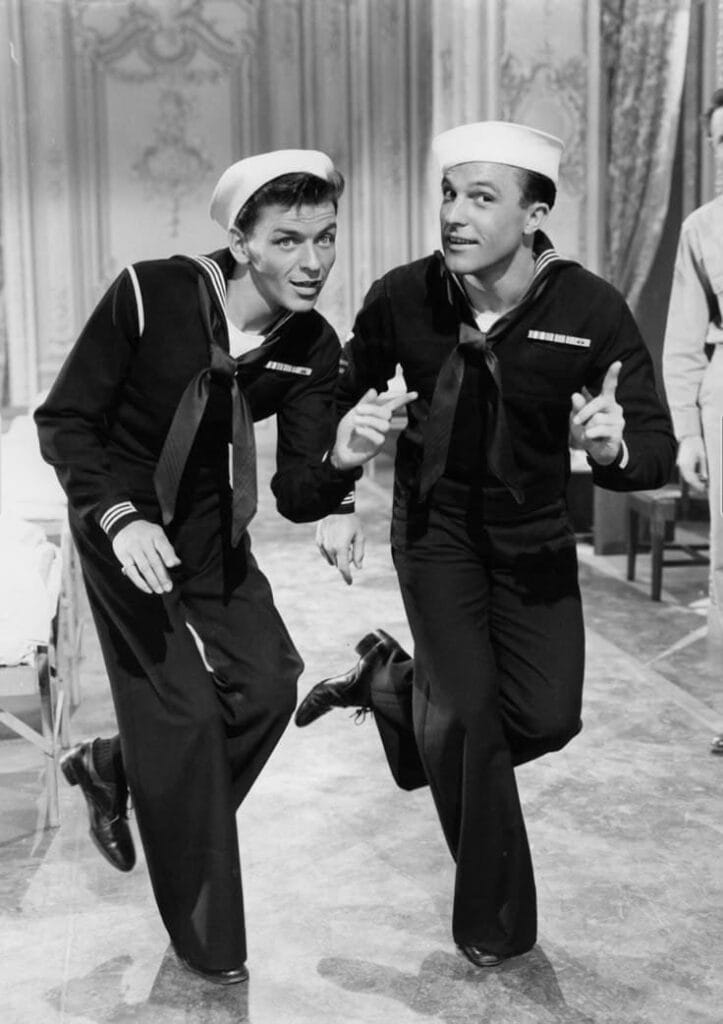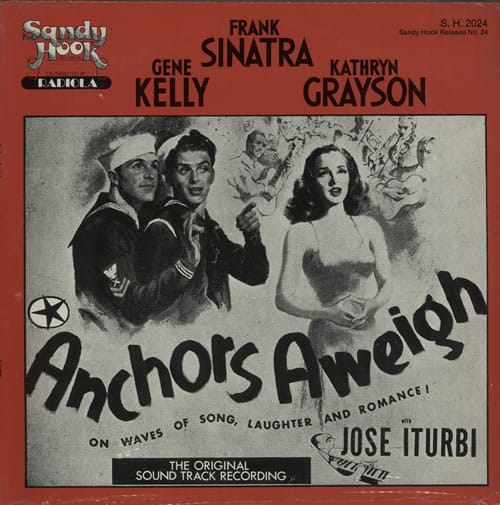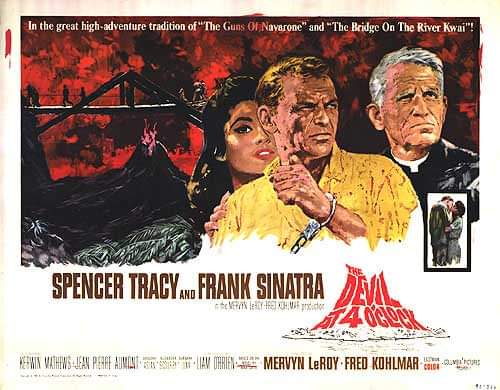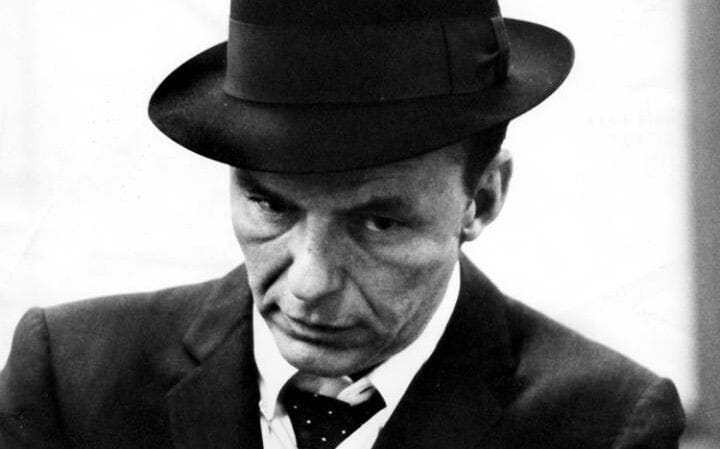
“Anchors Aweigh (1945) Part Two: Behind the Scenes and the Magic of Its Soundtrack”
Production
The budget of over two million dollars demonstrates the high expectations MGM had for the film “Anchors Aweigh”. The key figures involved had experience with films carrying the patriotic tone required for Anchors Aweigh. The production was overseen by Joe Pasternak (1901–1991), who had already achieved major box office success with Presenting Lily Mars (1943), starring Judy Garland and Van Heflin, and Thousands Cheer (1943), featuring Kathryn Grayson and Gene Kelly.
For direction, MGM chose George Sidney (1916–2002), considered one of the best in the business. His previous achievements included Pilot #5 (1943), starring Franchot Tone, Marsha Hunt, and Gene Kelly, and Bathing Beauty (1944), with Esther Williams and Red Skelton. Most of the movie was filmed on studio soundstages, though some scenes were shot at the legendary Hollywood Bowl.
The studio was aware of Sinatra’s inexperience as a dancer, so the script only required him to perform one dance number with Kelly—the delightful I Begged Her. Despite this, the singer had to endure eight full weeks of rehearsals. Sinatra despised rehearsing, lost patience with precise technical processes, and believed they sacrificed the natural flow of his performance. It is said that it was during this production that he earned the nickname “One-Take Charlie.”
Rehearsing daily until he was exhausted and sore must have been traumatic for him, but he accepted it as an unavoidable part of his contract. He was incredibly fortunate to have Gene Kelly, a man of infinite patience, who meticulously taught him how to move like a dancer and endured his co-star’s frequent tantrums. Sinatra’s lack of skill imposed certain limitations on Kelly himself, something the singer later acknowledged:
“I couldn’t dance exactly like him, so he lowered his level to mine.”
Despite his insecurities, Sinatra, according to Kelly, worked harder than anyone. Proof of his dedication lies in the fact that he lost nearly five pounds during the first rehearsal alone—something he could hardly afford, as he was already too thin. To maintain a healthy weight, he had to drink multiple milkshakes a day for two weeks.
Filming began on June 15, 1944, and the workload was so intense that Sinatra, exhausted, walked off the set during one of the early shooting days. This unprecedented act of defiance infuriated Louis B. Mayer, who stormed onto the set demanding Sinatra return immediately, but the singer refused. Kelly stood by Sinatra against Mayer, arguing that he was pushing himself to his limit.
Mayer liked Sinatra and admired his talent as a singer, but, being used to having his authority go unquestioned, he found it difficult to overlook each act of insubordination. As we will see in the sections on the soundtrack and trivia, there were more confrontations, each riskier than the last.
Soundtrack
Metro-Goldwyn-Mayer aimed to deliver the best possible sound for its musicals and spared no expense on human or technical resources. Composer Johnny Green, known for standards like Body and Soul and I Cover the Waterfront, was appointed head of the music department and set out to assemble an orchestra with a level comparable to any symphony in the world. He achieved this with the help of a distinguished team of conductors and arrangers, including Georgie Stoll, Conrad Salinger, Adolph Deutsch, Lennie Hayton, and Leo Arnaud, all of whom worked with Sinatra on various recording sessions over the years.
MGM’s recording studio, known as Soundstage One, built between 1928 and 1929, was—and still is—one of the best in the world, thanks to its acoustic quality and spacious dimensions. Additionally, Green conducted countless tests to optimize the sound to the highest degree.
The film’s songs were recorded at Soundstage One between June 13 and September 1944. Between October 23 and December 3 of that same year, new “commercial” versions of the songs were recorded for release on Columbia Records, including several singles exclusively for the U.S. military—the well-known V-Discs.
Joe Pasternak wanted the film’s songs to bear the signature of great names from the Great American Songbook, such as Jerome Kern, Ira Gershwin, or the duo Richard Rodgers and Lorenz Hart. However, Frank Sinatra insisted on working with his friends, songwriters Sammy Cahn and Jule Styne, who were still relatively unknown in Hollywood. This dispute caused further tensions with the studio, to the point that Sinatra’s agent, Lew Wasserman, feared his client might be fired if he continued defying MGM executives.
Sinatra did not back down and ultimately succeeded in getting the Cahn-Styne duo to write the songs. In the short term, his stubbornness benefited the entire industry, as both musicians went on to become some of the most prolific hitmakers in film throughout the 1940s, 1950s, and 1960s.
The film’s songs enhance both comedic and romantic moments. The lively, playful numbers fit seamlessly within the storyline, while the ballads composed for Sinatra possess a timeless quality that transcends the screen, reflecting his unique interpretative style. Additionally, classical music pieces and Hispanic folk songs were incorporated to complement different moments in the story.
Article written by Mahnuel Muñoz. Facebook group “Al Mal Tiempo, Frank Sinatra“. https://www.facebook.com/groups/120950148274703

Access the Complete Filmography of Frank Sinatra in the following link of Sinatra Radio 24h https://sinatraradio24h.com/category/filmography
We remind you that you can also listen to Sinatra Radio 24 hours on your mobile phone by downloading our free applications for Android in the Play Store https://play.google.com/store/apps/details?id=sinatra.radio24h for iPhone in the Apple Store https://apps.apple.com/app/sinatra-radio-24h/id6599859344









